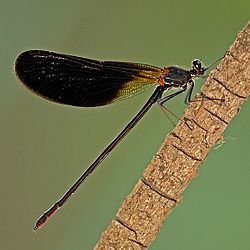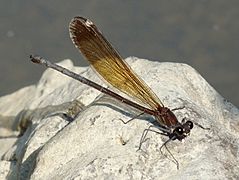Copper demoiselle facts for kids
Quick facts for kids Copper demoiselle |
|
|---|---|
 |
|
| Calopteryx haemorrhoidalis, male | |
| Conservation status | |
| Scientific classification | |
| Kingdom: | |
| Phylum: | |
| Class: | |
| Order: | |
| Suborder: | |
| Family: |
Calopterygidae
|
| Genus: | |
| Species: |
C. haemorrhoidalis
|
| Binomial name | |
| Calopteryx haemorrhoidalis Vander Linden, 1825
|
|
The Calopteryx haemorrhoidalis is a beautiful type of damselfly. It is also known by its common names, the copper demoiselle or the Mediterranean demoiselle. This insect belongs to the Calopterygidae family.
Contents
Different Types of Copper Demoiselles
Just like some animals have different breeds, this damselfly has several subspecies. These are slightly different versions of the same species.
- Calopteryx haemorrhoidalis haemorrhoidalis
- Calopteryx haemorrhoidalis occasi
- Calopteryx haemorrhoidalis asturica
- Calopteryx haemorrhoidalis almogravensis
Where They Live
The Copper Demoiselle is native to parts of Europe and North Africa. You can find it around the western Mediterranean. This includes countries like France, Italy, Monaco, Portugal, and Spain. It also lives in North Africa, in places like Algeria, Morocco, and Tunisia. It is quite common in many of these areas.
Their Home (Habitat)
These damselflies love to live near water. You will often find them along rivers and streams. They also enjoy sunny, larger bodies of water. Changes to their home, like water pollution, can affect them.
What They Look Like
The Copper Demoiselle can grow to be about 45 to 48 millimeters (about 1.8 to 1.9 inches) long.
- Males usually have an abdomen (the long back part of their body) that is 34 to 43 millimeters long.
- Females have an abdomen that is 31 to 43 millimeters long.
- The wings of males are about 23 to 32 millimeters long.
- Female wings are a bit longer, from 25 to 37 millimeters.
Male Damselflies
Male Copper Demoiselles have a dark body that shines like metal. Their color can be red-violet, golden, or copper-colored. They have a special red area on the underside of their last three body segments. This is called the "red lantern." The Latin name haemorrhoidalis refers to this red area. The wings of the males have a large dark patch.
Female Damselflies
Females look a bit different. Their body is metallic-green to bronze-colored. They have a brown band near the tip of their wings. They also have a brown belt on their back.
How They Live
You can usually see these damselflies flying from May to September.
Mating Dance
Males have a special mating dance. They show off the end of their abdomen and spread their wings wide. This helps them attract a female.
Territorial Behavior
Male damselflies are also very territorial. They will defend areas where females might want to lay their eggs. This means they will try to keep other males away from their chosen spots.
Mixing Species
Sometimes, this species can hybridize with another damselfly called Calopteryx splendens. This means they can sometimes have offspring together.
Gallery






